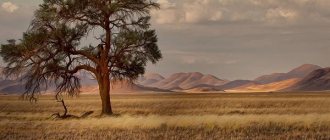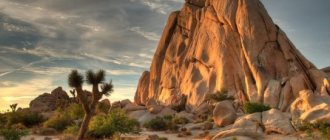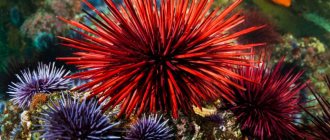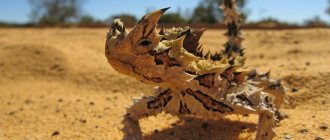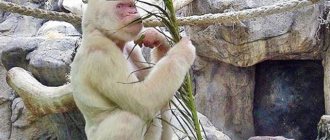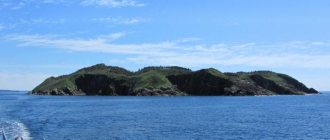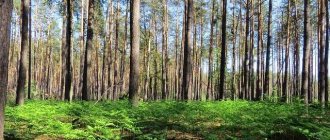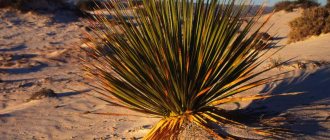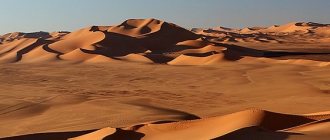Deserts and semi-deserts of Eurasia extend from the Caspian lowland to China. In Russia, this natural zone occupies the territory of the southeastern regions of the country. The Arctic desert is located on the territory of the northern islands of Russia. A distinctive feature of deserts and semi-deserts is the high fluctuation of winter and summer temperatures. Semi-deserts are located in the northern part of the natural zone. The climate here is milder, so they are characterized by a steppe landscape. Closer to the south, where the climate becomes arid and vegetation cover practically disappears, there is a desert zone.
Geographical position
Semi-deserts in Russia occupy small spaces in the southeast of the East European Plain and the Caspian Lowland . Actually, deserts in Russia. They occupy only a tiny area on the northern coast of the Caspian Sea from the mouth of the Terek River to the state border with Kazakhstan. These deserts are nothing more than the northwestern edge of the vast deserts of Central Asia.
The northern border of the Russian deserts runs just south of Volgograd. They occupy the territory of the Volgograd and Astrakhan regions
Protection of natural areas
Some desert areas are protected by law and recognized as nature reserves and national parks. The list of them is quite long. From the deserts man guards:
- Etosha;
- Joshua Tree (in Death Valley).
Among semi-deserts the following are subject to protection:
- Ustyurt Nature Reserve;
- Tiger beam.
Important! The Red Book includes such desert inhabitants as the serval, mole rat, caracal, and saiga.
Rice. 6. Chara desert. Transbaikal region
Climate
Semi-deserts
Dry and sharply continental . The annual precipitation varies between 250–400 mm. Despite its southern location, winter here is cold . The average January temperature is 5–8 °C below zero, and on some days the thermometer can drop to –30 °C. Summer is hot and sunny . Precipitation occurs in the form of short showers . Sometimes you can observe “dry” thunderstorms and “dry” rains, when drops evaporate before reaching the ground. It is often so hot that lakes and rivers dry up, vegetation burns out, and gophers hibernate at the beginning of summer.
Deserts
The desert zone is the area that receives the largest amount of solar radiation in Russia. The summer here is really hot (the average temperature in July is +22–25 °C), but the winter is cold and snowless (in January –12–16 °C, the thickness of the snow cover rarely reaches 10 cm).
In the desert zone, the range of day and night temperatures can reach 60°C
Arctic desert of Russia
Main article: Description and features of the natural zone of Arctic deserts
The southern border of the Arctic desert territory is the Russian Wrangel Island. In addition to it, the natural zone includes the New Siberian Islands, Franz Josef Land, Severnaya Zemlya, part of Novaya Zemlya and part of the Taimyr Peninsula.
During the polar night, which lasts 90 days, winter begins. Summer comes with a polar day. There are no transitional seasons. Winter temperatures are low, down to -60°C. There is little precipitation. Winds blow snow cover off the soil. Summer doesn't last long. The air temperature in July is +3°C. During the polar day, the sun does not warm the air well. The snow does not melt for 300 days a year, and winter comes overnight.
Trees and bushes are completely absent. In summer the lands are covered with lichens and mosses. Sedge and cereals grow on rocky soil. In the Arctic desert in summer you can find green oases with polar poppy, saxifrage, buttercup and Arctic pike.
The soil thaws to a depth of 40 cm. Iron oxides accumulate in the upper part, causing the soil to acquire a brown tint. There is sand and stones on the surface. Spherical formations, spherulites, are a landmark of cold deserts.
The fauna is scarce. Animals living in the Arctic desert feed on seafood. Polar bears, leading a semi-aquatic lifestyle, breed off the coast of Chukotka, on Franz Josef Land. In the Wrangel Island Arctic Nature Reserve, dens have been created for them. Arctic foxes, lemmings, hares, and reindeer come from the tundra for the summer. Seals and walruses set up their rookeries on the coast. Birds are considered the most numerous class. Bird markets are organized by eider ducks, gulls, tundra partridges, guillemots, and terns. When the polar day arrives, snow geese, geese, plovers and dunlins flock to the Arctic.
Soils
Russian deserts and semi-deserts are characterized by light chestnut soils on which cereals and wormwood grow. The thickness of the humus horizon is small - only 40 cm. In general, the soils of these natural zones are usually very salty, since moisture is insignificant , and small volumes of biomass entering the soil are almost instantly mineralized. As a result, significant areas are occupied by solonetzes. In the south of the Caspian lowland, in some places you can find brown desert-steppe soils .
Lake Elton is a Russian “salt shaker”. The largest mineral lake in Europe by area and one of the most mineralized in the world. Located in the Volgograd semi-desert near the border with Kazakhstan
Vegetation of tropical and subtropical regions
The flora of deserts is very specific and sparse due to low humidity levels: without water it is impossible to carry out photosynthesis. However, life has adapted to such unfavorable conditions: tropical desert plants of the xerophytic type have a predominance of spiny, fleshy and resistant cactus-like species with a large storage capacity for the resulting water. Semi-deserts are dominated by weeds and, at best, short shrubs. Some of the most common plants of deserts and semi-deserts are:
- Beavertail cactus.
- Choya cactus.
- Opuntia common.
- Governor or creosote bush.
- Poppy, California poppy or Arizona poppy.
- Juniper.
- Ocotillo, rotilla.
- Wheelers, tumbleweed, flyer, salsola.
- Mezquites or carob trees.
- Peach.
- Iron tree.
- Aloe vera.
- Stone cactus.
In the few oases, water allows life to become more widespread, and tall palm trees and shrubs, including fruit trees such as dates and coconuts, can be seen.
The desert is a very difficult place for living things to live due to the dry and hot air. Under normal conditions, to absorb nutrients from their roots, plants evaporate water from their leaves through the process of transpiration. But in the desert, where water is scarce, many species have adaptations that help them store it. Such plants are called xerophytes.
Cacti and other plants that store large amounts of water to survive the dry season are known as succulents. Even during light rainfall, succulents absorb as much water as they can store, storing it in their roots, leaves or stems.
Fight for water
For some plants, the only way to make sure they can get enough water is to get rid of their competitors—other plants nearby . The creosote bush produces special chemicals or toxins that are released into the nearby soil. These toxins make it difficult for other plants nearby to grow. This property is known as allelopathy.
However, some desert plants do not store much water but do not die but become inactive during the dry season. They have the ability to withstand the hottest and driest times of the year.
These plants use a variety of techniques to cope with desert conditions. For example, the spines of cacti and some other plants help them provide shade while protecting themselves from exposure to sunlight. Some plants, such as the mosque tree, have very long primary roots that can extend up to 30 meters underground and reach groundwater stored at great depths.
Desert Animals
Contrary to popular belief, the desert is home to many animals . They are adapted to the environment and are focused on maintaining moisture in their body. Reptiles (snakes, lizards), insects, ants, beetles and scorpion arachnids, spiders, abound in deserts and semi-deserts.
There are also numerous desert rodents that hide in burrows to get shelter from the daytime sun. These rodents serve as food for birds of prey and snakes. Finally, camels with the highest drought tolerance can be found here.
It is common for these animals to have insulating layers to protect them from the sun and drying out, or to have water reserves in various organs of the body in order to avoid drinking for long periods of time . Examples of desert animals:
- Camels.
- Scorpios.
- Rattlesnakes.
- Dingo dog.
- Ostrich.
- Coyote.
- Egyptian cobra.
- Camel spider.
- Grif.
- Desert woodpecker.
- Western desert tarantula.
- Namibian beetle.
- Red kangaroo.
- Desert iguana.
- Puma or American lion.
Desert animals have developed, over millions of years of evolution, a variety of physical, biochemical or behavioral abilities that allow them to survive and reproduce in complex desert habitats.
Many of these animals are nocturnal, as temperatures drop significantly after sunset. For this reason, they hide during the day, in the most abundant vegetation (cacti and bushes) or under the sand itself, seeking freshness from the depths.
Plants
Semi-deserts
They are characterized by such plant species as tree and gnarled saltwort , camel thorn, and juzgun . The higher elevations are dominated by feather grass and fescue .
In the desert zone there is the delta of the longest river in Europe - the Volga. Here is the unique Volga-Akhtuba floodplain, which is often called an oasis. This area is home to luxurious lotus fields.
Deserts
Typical plants are ephemerals - low, small, with a very short growing season. They become active during more or less humid periods, drying up at other times and showing no signs of life. In the deserts of the Caspian lowland, wormwood rules.
Desert plants (for example, wormwood) have adapted to harsh conditions: protective caps on the roots protect them after sand is blown out
The opinion that the desert is a completely lifeless space is wrong. There is vegetation here, but it does not form a continuous cover
Gazelle Dorcas
These animals are similar to the common gazelle, but are much smaller. They live mainly in northern Africa. Dorcas is well adapted for life in the desert and can easily withstand high ambient temperatures. She can do without drinking water, obtaining the necessary liquid from the plants she eats.
Animals
The fauna of semi-deserts and deserts is poor compared to the forest zone. The most common are reptiles (lizards, snakes, turtles), many rodents (gerbils, jerboas) and poisonous arachnids (scorpions, tarantulas, karakurts). Here you can see birds - little bustard, lark. The largest mammals include the camel and the saiga; there are corsac dogs and wolves.
Among the animals in semi-deserts and deserts there are many rodents (jerboas, gophers, gerbils) and reptiles (lizards, turtles, snakes)
Horned viper
A sandy-yellow body up to 80 cm long, a flat head above which rises a pair of sharp horns, an unusual manner of movement – these are the features of this reptile. The viper is well known in the arid regions of North Africa and the Arabian Peninsula. The reptile camouflages itself well, burrowing into the sand, and feeds on small rodents, birds and lizards.
Human
The traditional occupation of the population in the semi-desert and desert zones is cattle breeding : sheep, camels, and cattle are bred here. Due to overgrazing by domestic animals, the area of unconsolidated sand increases, and “bare” lands . In many areas, the problem has reached catastrophic proportions: the size of the herd is three or more times greater than the capacity of the pastures - the vegetation does not have time to recover. The result of this led to sad consequences - the largest desert in Europe was formed in Kalmykia.
Share link
Lizards of the Sahara
A typical representative of the Sahara Desert lizards is the spiny tail (Uromastyx) from the agam family. This animal seems clumsy. It has a flattened body and a small head, reminiscent of a turtle's head. Particularly striking is the short tail, covered with protruding prickly scales, which serves for defense. In case of danger, thorntails hide their heads in a shelter, and use their barbed tail to fight off the enemy.
Spiketails are perfectly protected from the strong temperature fluctuations characteristic of the desert. To do this, they change color. In the early morning, when freshness is still retained after a cold night, the lizards darken, and the sun heats the body that has cooled during the night.
Spinytails are herbivorous animals; only young individuals sometimes diversify their diet with insects.
The pharmacy skink (Scincus scincus) is one of the most famous representatives of skinks, an integral element of the desert fauna.
This lizard, which looks like a miniature crocodile, moves deftly along the surface and inside the sand. Short but strong legs serve as support, the tail serves as a rudder, and the sharp edges of the belly cut through the sand. When the skink moves, it appears as if it is swimming through the sand.
The skink is unpretentious in food, however, like other desert animals. It gnaws on everything it can handle: beetles, their larvae, locusts, centipedes, etc. Whenever possible, it happily eats flowers, leaves, pods and seeds.
The skink has also learned to conserve energy and water. This is the only way to survive in an extremely dry and scarce environment. It uses the liquid contained in the prey as a source of moisture, and accumulates fat as a reserve at the root of the tail. If the sand is too hot during the day and too cold at night, the skink burrows to a depth of 20 cm in loose sand, where the temperature is more comfortable.
Interesting Facts:
- The two largest deserts on planet Earth: Antarctica and the Sahara.
- The height of the highest dunes reaches 180 meters.
- The driest and hottest area in the world is Death Valley. But, nevertheless, more than 40 species of reptiles, animals and plants live in it.
- Approximately 46,000 square miles of arable land turns to desert each year. This process is called desertification. According to the UN, the problem threatens the lives of more than 1 billion people.
- When passing through the Sahara, people often see mirages. To protect travelers, a mirage map was compiled for caravan drivers.
For even more interesting facts and useful information about these climate zones, watch the video below.
Source: nauka.club

